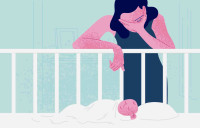As it is
How are you doing?
Unexplained or multiple somatic symptoms are strongly associated with coexisting depressive and anxiety disorders.
Shuvangi Khadka
I wrote invisible letters on the dust settled near door crevices
with my bare fingertips,
I didn’t care about my fingers covered in brown dust.
I didn’t feel the compulsion to rinse them off.
Everything, from squeaky door hinge to gurgling tap water
reminded me that my life was slipping away.
—December, 2020
December of 2020 was earmarked with hospital visits. The first stop was Tilganga Eye hospital. Under the experienced eyes of a well-renowned ophthalmologist, I was certain my blurry vision would be restored.
A week of moisture supplanted through eye drops failed to make any difference. I continued waking up with frequent nausea and eye blurs. I soon lost count of hospitals and pharmacies we rushed to. My days started lining up like waiting chairs in dimly lit, funnel smelling hallways.
In a way, I was glad it was happening after I had completed my final semester classes. At least I could devote my whole time tending to these mysterious symptoms. At least my confused, anxious brain was preoccupied—in a way.
Then one evening, my final, much awaited CT scan report emerged with “Normal” status. I was almost disappointed. I almost wished there would be some anomaly, some physical explanation. I wanted to pinpoint a cause. Somehow, just dissect, remove, or cut it off. I just couldn’t bear to wake up every morning with it. I guess I had put so much expectations in medical science to forget that healing is a slow, tedious process.
Dr Eliza Karki, consultant psychiatrist at Dhulikhel Hospital and lecturer at KUSMS, says such instances are not rare.
Recently, a 30-year-old woman visited the out-patient-department (OPD) of Dhulikhel Hospital with persistent stomach discomfort. She was diagnosed with gastritis but did not recover from the pain even after using the prescribed medication. Later when she was referred to the psychiatry department, the discomfort was found to be the result of anxiety.
Usually people associate symptoms of mental illness being limited to psychological feelings like feeling of panic, insomnia, personality change, extreme mood swings, etc. After all those visits, when my medical resident sister finally said “Maybe it is not something physical,” I was not ready to acknowledge it. Sure, I took a lot of stress but I only associated mental illness with anxiety attacks that often greeted me. My blurring vision did not fall within its purview.
However, contrary to popular belief, somatic symptoms or medically unexplained physical symptoms are found to be the predominant reason why patients with common mental disorders such as depression and anxiety initially present in primary care. In a research conducted last year at BPKIHS, Dharan, 53.33 percent of people calling the psychiatry helpline complained of somatic symptoms.
Dr Eliza says people who are not very aware about mental health first arrive with somatic symptoms like epigastric discomfort, body ache, headache, burning sensation or other pain. According to her, these symptoms can most of the times overlap between physical and mental illness due to their interconnectedness.
Unexplained or multiple somatic symptoms are strongly associated with coexisting depressive and anxiety disorders or may also be an indication of somatic symptom disorder. Such symptoms include conditions like irritable bowel syndrome (IBS), chronic fatigue syndrome; chronic pain; fibromyalgia; palpitations; insomnia; tinnitus; numbness; skin conditions; chest/joint/muscle/abdominal pain; headaches; back pain and more.
“Physical symptoms can be seen not only in neurosis (e.g. anxiety, depression) but also in psychosis (e.g. schizophrenia, delusional disorders, etc.). But in case of neurosis, it may be easier to pinpoint symptoms as patients usually have general insight about illness and their subjective self,” says Dr Ashish Dhakal, consultant neuropsychiatrist at BNC Hospital, Jhapa. In neurosis, he says, the basic aim becomes to relieve stress of patients.
Post the first wave of COVID-19, Dhulikhel Hospital saw a surge of COVID patients, including medical personnel and their relatives, complaining of chest pain, difficulty in breathing, feeling suffocation, etc. In most cases, these were later attributed to anxiety. After ruling out all possible causes like increase in sugar, thyroid, etc., the perpetrator was found to be the eminent stress which surrounds all of our lives right now.
The fear of contracting the virus has been fuelled with limited social life, bombardment of distressing news all over the media and increasing uncertainty whether we’ll ever go back to earlier times.
But when physical symptoms manifest, people usually consult with different physicians and go through the same tests in different places to find a physical explanation. When there isn’t one, it often leads to frustration, which further aggravates stress and the cycle continues. Gradually, the effect becomes the cause, reinforcing the original cause and produces an intensified effect. And if further medical evaluation is not warranted, it may lead to unmet patient expectations and increased provider frustration.
During my unfruitful hospital visits all through December, I held onto my tiny spiral notebook and a pen. I was convinced that one of those days I would die without my condition ever being detected and like a fragile human being I desperately wanted to leave a mark. So, I wrote frivolously, mostly about avoiding death. Writing emptied and filled me up simultaneously with such feelings that for a moment I could credit my blurry vision solely to swelling tears.
It was much later, I understood the importance of introspection. Like Dr Eliza says, “If no physical cause can be determined even after doing a basic baseline investigation, a person should reflect if his/her condition may be the symptom of deteriorating mental health.”
Most of the time, mental illness is perceived to be ‘only in our minds’ which makes it easy to shrug it off. But our being is so intricate that there is no body-mind dualism. In contrast, our overall well-being exists in a spectrum of physical and mental health characteristics.
Particularly, we need to come to terms with the fact that the current situation has taken a toll on our health, both physically and mentally. And its effects may manifest in different forms.
At this point, it may not be convenient to get face-to-face medical help but hospitals like Teaching Hospital are offering toll free helpline numbers. Similarly, organisations like Koshish Nepal through their radio show or Counselling Psychology Nepal through Google forms are finding ways to provide free mental health services.
Additionally, we can also try some stress management techniques at home.
“Commonly, what we can employ is moderate physical workout about 30 minutes per day, early morning shower, breathing exercises for relaxation and mindfulness. I have personally found Sudarshan kriya and Sahaj samadhi taught by the Art of Living to be quite beneficial among my patients,” says Dr Ashish.
Similarly, Dr Eliza has found practices such as yoga, meditation, deep breathing exercises or techniques like Jacobson relaxation to relax patients with anxiety or somatic symptoms. She also recommends making and following a routine which helps to maintain adequate balance in one’s life.
Few days back, I called my sister and explained to her in length about discomfort in my ear since early morning, which Web MD explained as having a “ringing ear”. The causes I narrowed down to were either ear damage or stress. Between the two of them, I almost settled with the first. But during the day when I was in a Zoom meeting with people I loved, I noticed the ringing in my ear gradually subsiding and sometimes even completely disappearing. As the day progressed, the ringing changed its existence almost like a shapeshifter.
Reeling under the work from home mode during a pandemic, I had stopped writing like I used to. I found very little time outside endless ‘work’ hours. Weekdays had transformed into deadlines, and the world had been reduced into a window cut-out shape and COVID update notifications. I vowed, this wouldn’t do.
Over the period of two-three days, I took a lot of breaks. I attended my mother’s budding cucumber tendrils and purple brinjal flowers. I started writing again, for my own enjoyment. I often think about what Paul Bowles said “Because we don’t know when we will die, we get to think of life as an inexhaustible well. Yet, everything happens a certain number of times, and a very small number really.”
I also started a journal, tracking my feelings. I remind myself to wake up to a day full of possibilities. The ringing in my ears is almost non-existent now. And God forbid even if it returns someday, at least I know which OPD in a hospital to head next.
Medical toll free helpline numbers:
Teaching hospital: 9849630430
Koshish Nepal: 1660 01 22322




 13.12°C Kathmandu
13.12°C Kathmandu










